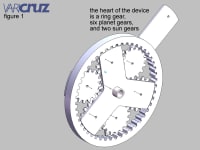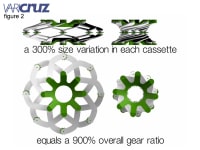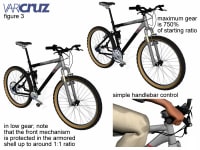Friction based variable transmissions, in the form of belts and cones, have been in existence for many years. One successful new version, based around ball bearings and shaped steel surfaces, is the NuVinci drive. However, all friction based transmissions suffer from mechanical inefficiency and limited power capability. Innovators have been trying to develop a chain-based variable transmission for over a century. Many concepts have been patented, but all are complex and delicate mechanisms unsuited to mass manufacture; none is in production.
The VariCruz is a remarkably simple chain-linked variable gear transmission that is built from a handful of simple components in circular arrays. Figure 1 shows the heart of the device: an arrangement of sun and planet gears that allow two concentric rotating elements to have their relative angle adjusted whether they are rotating or stationary. An animated explanation of this mechanism is at http://bit.ly/ckFMt8. Figure 2 shows an overlapping arrangement of arms whose effective diameter can be adjusted by the relative change in angle of these two concentric elements. The ends of the arms carry devices which engage with the chain links in one direction but allow the chain to slide unobstructed in the other, similar in action to conventional sprockets. An animation of the arm action can be seen at http://bit.ly/aSS1lN.
Figure 3 shows a bicycle powered by a VariCruz. This has two identical cassettes controlled by one handlebar twist grip. The device as shown offers a 750% gearing range – higher than a typical 525% 27-speed derailleur – with the added safety feature of being able to change gear when stopped unexpectedly in traffic. The addition of spring loading inside the cassette (not shown) turns the device from speed-selection (ie, a conventional transmission) to torque-selection (an automatic transmission, where the rider chooses the amount of force they want to exert on the pedals and the VariCruz changes its gearing to keep that force constant no matter what the gradient). The components are simpler than a derailleur and for the mass market can even be stamped rather than machined. An animation can be seen at http://bit.ly/bPYBmL.
Finally, the VariCruz mechanism, being based on conventional gears and a chain linkage, is effectively size independent. The device can be three inches or thirty feet long, and drive items varying from office equipment and industrial machinery such as lathes and power drills to large vehicles and ships. It offers greater efficiency than friction based variable transmissions, and if two systems are chained (with the added advantage that input and output shafts can be coaxial) the speed range from one control is vast.
Benchtop prototypes have been successfully tested; the inventor is currently developing a miniaturized version to be fitted to a bicycle and will then seek venture capital or angel investment funding.
The VariCruz mechanism is the subject of patent application 12/756,996, filed through Sonnenschein Nath & Rosenthal LLP of Palo Alto, CA. For further information please contact Chris Yonge, Studio Cruz, 227 Morrissey Boulevard, Santa Cruz, CA 95062.
Like this entry?
-
About the Entrant
- Name:Christopher Yonge
- Type of entry:individual
- Hardware used for this entry:Dell and Boxx workstationsSoftware used for this entry:Rhinoceros, SolidWorks, 3D Studio Max
- Patent status:pending








